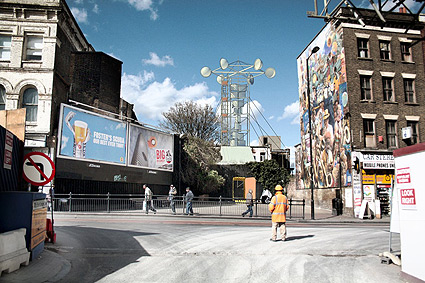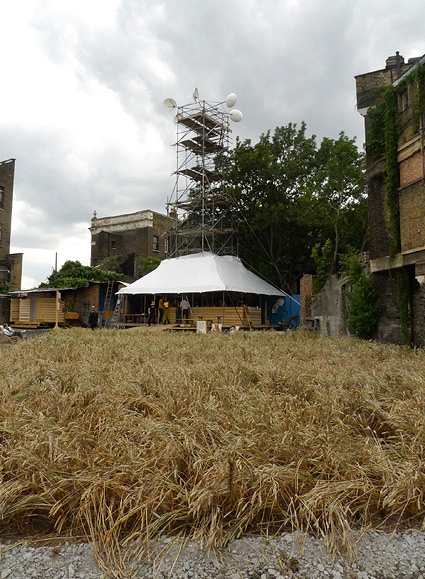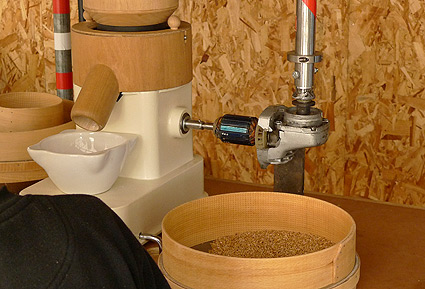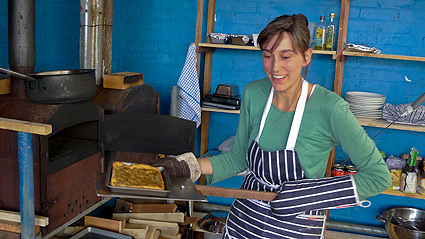The Radical Nature – Art and Architecture for a Changing Planet 1969-2009 exhibition, which is currently on at the Barbican Gallery (previously covered by Régine) also consists of several off-sites. They aim to engage with the city of London and make some of the themes of the show more palpable and real, if you want.
 Rendering of the Mill, view from Dalston Lane (from EXYZT’s Flickr)
Rendering of the Mill, view from Dalston Lane (from EXYZT’s Flickr)
I went to visit the double piece which is located in London’s North-East district of Dalston where both a re-staging of a work from the exhibition, Agnes Denes‘ Wheatfield, A Confrontation and a new commission, The Dalston Mill by Paris-based experimental architects EXYZT. The site itself is part of an abandoned railway line (the Dalston Junction Eastern Curve) and had recently been filled in with gravel to be used as a car park. Both pieces in fact form a temporary functional ensemble and eventually the mill will be processing grains from the field when the wheat is ready to be harvested.
 The Wheatfield and the Dalston Mill, two days after opening
The Wheatfield and the Dalston Mill, two days after opening
The field is basically a re-creation of the Manhattan field from 1982, but it’s much smaller and the backdrop is quite different, in that case an abandoned house and the Kingsland Shopping Centre, which is so absolutely puzzling in terms of style that it actually makes an intriguing and very London-like backdrop for the piece. The stark contrast between local production of food and the front-end of its industrialized production also makes for a nice update to the ‘confrontation’ side of the original piece. One could even say that it is being inverted in an interesting way as the 1982 version was partly about exporting the harvested grains to 28 cities worldwide and planting them there. Visitors are invited to sit by the field and, considering that it is jammed in between extremely busy streets and several construction sites, it feels like an island of peace in one of the madder areas of London.
The mill itself was designed by EXYZT, a collective that many Londoners are familiar with through their Southwark Lido, a temporary structure they created in 2008 together with Sara Muzio for the Architecture Foundation and which was based around the idea of “a community of users actively creating and inhabiting their urban environment [as] key to generating a vibrant city”. Sara is part of this project as well, creating a documentary about it and was working in the Mill’s bakery when I got there. She explained that this project, although consisting of a very different setup, is built around the same ideas of the ‘functional city’. Here, structures, apart from providing shelter, can also take on tasks like generating electricity or grinding wheat and provide a shared platform for the local residents.
 The servo pole, gears and modified wheat grinder
The servo pole, gears and modified wheat grinder
The mill itself is 16 meters high and the main structure is built from a scaffolding typically used in construction. The six hemispherical sweeps at the top have been made from resin and are arranged in a hexagon. From there, a servo pole leads down to the bar area where it meets a small customized grain grinder which, whenever the wind moves the big structure above is making a few turns. Interestingly, there is also a series of gears which drives a small generator that is charging a battery which at night powers bars of LEDs in different corners to light up the building.
It all moves very slowly and does neither generate a lot of flour nor energy, but it’s fascinating to see how the attempt on creating a somewhat autonomous structure in the middle of a highly developed cityscape actually works and above all creates a very pleasant space around itself. However, to drive things like fridges and music, the mill has to have a secondary circuit which actually hooks into the mains because the wind does not generate enough power. It would be interesting to further look at how something like the Kingsland Shopping Centre and an ensemble of Mill and Wheatfield actually compare, as functional spaces and in relation to the absolute space they occupy in a city.
 Architect Sara Muzio making focaccia using flour from the Mill
Architect Sara Muzio making focaccia using flour from the Mill
The Dalston Mill and the Wheatfield is unfortunately only up for three weeks in total and will close on August 6th, so make sure you go check it out if you are in London. It is open daily from 2-10pm, and there is a program of events scheduled (including a conversation with EXYZT about ‘pirate architecture’ on August 2nd) which mainly focuses on notions around community and sustainability.
Entrance by the Peace Mural on Dalston Lane, between Ashwin Street and Hartwell Street, London E8.
More photos. Related: Radical Nature – Art and Architecture for a Changing Planet 1969-2009







